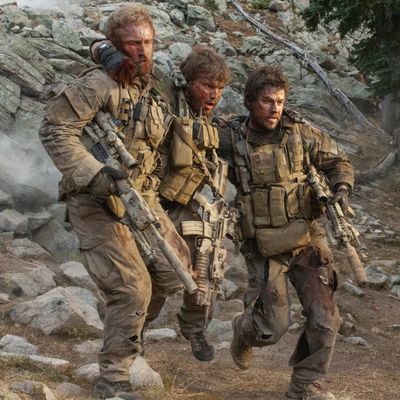
When it comes to war movies, it’s tough to present something that genuinely feels new: So many different wars have been filmed in so many similar ways onscreen, and when something does come along that finally feels fresh — say, Steven Spielberg’s jittery storming-the-beach sequence in Saving Private Ryan — it’s relentlessly plundered by other, lesser movies until those techniques simply become expected. Certainly, much of Peter Berg’s new film, Lone Survivor, owes a debt to the war movies that have come before it (particularly Ridley Scott’s mission-gone-wrong horror story Black Hawk Down), and though it’s compellingly made and based on a true story, the movie goes about its business in mostly familiar ways: As the film’s Navy SEAL heroes are shot at during an aborted mission in the hills of Afghanistan, bullets whiz past the actors’ faces and blood squibs burst on their arms while the camera jumps and zooms in a documentary-like style.
And then our heroes jump off a cliff. And suddenly, the sort of scene that Hollywood had recently run into the ground — the brave leap off a tall mountain that our protagonist inevitably escapes unscathed — becomes bracingly, shockingly real.
The first of these jumps comes an hour into the movie, as the four SEALs have retreated into a cliff-top corner, their enemies outflanking them from all sides. “We’re falling back!” orders Taylor Kitsch’s Murphy. Mark Wahlberg as Luttrell glances at the steep drop behind them. “You mean fall off?” he says with some disbelief.
It’s their only option. And so, with a slow-mo flourish that initially seems like something Michael Bay might have shot, all four men jump off the cliff at the very last second, smoke from rocket rounds billowing behind them from the perch where they made their last-chance leap.
But after that ostentatiously heroic image, it’s positively brutal. The film ramps back up to normal speed as the SEALs spill down the hill, their skin split open on stone outcroppings, screaming, shouting, and grunting as they tumble down those treacherous slopes. Dirt and rocks fly up at the men as they skid forward face first (accompanied by sickeningly well-realized sound effects), colliding with trees and logs that stall their momentum at the mere cost of their bones. It’s only a 30-second-long scene, but it feels like it lasts an eternity. If you watch the sequence with a big audience, you can practically hear the gripped armrests squeaking, and you’ll definitely notice your fellow moviegoers’ full-body cringes and sucked-in breaths. After it’s over, you might even be tempted to check your own skin for bruises.
And then, almost seven minutes later, they do it again. This time when Kitsch says, “We’re movin’ down,” and the camera peers vertiginously past another cliff face, it’s even more terrifying because you know what you’re about to be put through again. Somehow, this one is even worse.
“Pain hurts,” Berg told us last month while explaining these scenes. “The cliff jumps in particular were reminiscent of 9/11, when people were jumping out of the World Trade Towers, just throwing themselves out of the towers because it was the only option they had.”
And if it looks like Lone Survivor’s falling scenes hurt for real, that’s because they did: “Oh, [the stuntmen] went for it. Broken ribs, punctured lungs, concussions,” said Berg. The vibe on set was so gung ho that Berg even had to convince his actors not to make the suicide leaps themselves. “Particularly Ben Foster and Taylor Kitsch, I had to keep pulling them off the hill, because they wanted to throw themselves off. A lot of my job was just to tell them, ‘You’re not going to throw yourself off a twenty-foot cliff.’”
If other films now emulate what Berg has done with those sequences, maybe there can finally be an end to what’s become an especially pernicious trend of movie leaps without consequence. Last year, while watching Chris Pine jump off a giant cliff in Star Trek Into Darkness or Jaden Smith swan-diving from up high in After Earth, it was hard to work up any feeling at all. Jumps like those ought to feel terrifying and dangerous — there’s a reason why a fall will so often wake you in the middle of a dream — but they’ve become just another trick in the action-movie arsenal, a meaningless thrill to goose the end of a chase sequence. There always seems to be an ocean down below or a conveniently placed dumpster that can cushion the hero’s giant leap, and no one walks away with even a scratch or a broken bone. When Harrison Ford made that waterfall leap in 1993’s The Fugitive, it was shocking; fifteen years later, when he plunged over an even bigger series of waterfalls in Indiana Jones and the Kingdom of the Crystal Skull, it was tedious and consequence-free. He didn’t even lose his hat.
I’m not calling for more violent action movies — certainly, most fight scenes these days pack a bruising punch that tests the outer limits of PG-13 — just consequences to the action beats we see onscreen. After Mark Wahlberg made those leaps in Lone Survivor and ended them bruised, broken, and spitting up blood, do we really want to see him jump another cliff in some other upcoming action flick and blithely survive like a cartoon Wile E. Coyote? The falling scenes in Lone Survivor seemed even more heroic because they had real stakes. If other movies can’t follow suit, they shouldn’t even bother to take the leap.

